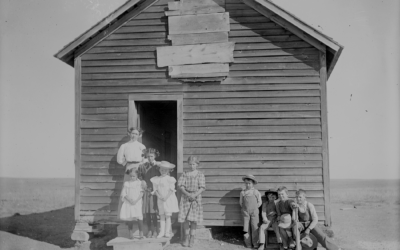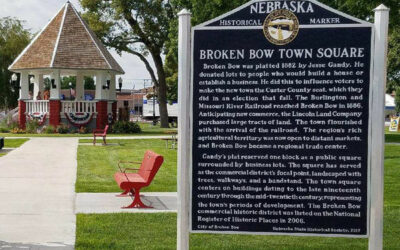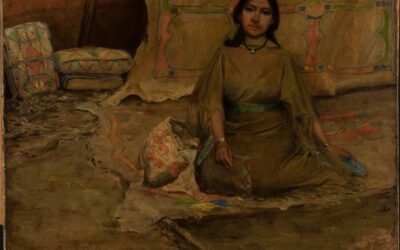
A facial reconstruction based on cranial structure, completed by Betty Pat Gatliff, now provides the only likeness of Gabriel Field.
By Patricia C. Gaster, Assistant Editor
This article first appeared in the January-February-March 2010 issue of Nebraska History News, published by the Nebraska State Historical Society (aka History Nebraska).
Lt. Gabriel Field was serving with the Sixth U.S. Infantry at Fort Atkinson when he died from an accidental knife wound on April 16, 1823, and was buried in the post cemetery. Fort Atkinson’s preservation, age, and research significance make it perhaps the most important Euroamerican archeological site in Nebraska. The Historical Society, in cooperation with the Game and Parks Commission, has conducted archeological investigations at the fort since the 1950s. The identification of Field’s remains is a remarkable result.
Field was a member of the Yellowstone Expedition, dispatched up the Missouri River in 1819 under Col. Henry Atkinson to build fortifications west of the Mississippi to protect the American fur trade and to prevent British encroachment from the north. Halted in present-day Nebraska by the approach of winter, the soldiers built their first outpost, Cantonment Missouri, on the river bottom north of the Council Bluff, where Lewis and Clark held a council with the Oto and Missouria Indians in 1804. Engineer Cantonment, the 1819-20 winter camp of Maj. Stephen H. Long’s scientific party, also a part of the Yellowstone Expedition, was established at the same time about five miles south. Cantonment Missouri was abandoned the following spring due to flooding, and a second post was built on the bluff top. In 1821 the new post, garrisoned by the Rifle Regiment and the Sixth Infantry, was officially designated Fort Atkinson.
The post’s peak population of more than one thousand included military personnel, some of their families, and other civilians. The rectangular fortification consisted of log barracks facing inward upon an enclosed parade ground with loopholes on the exterior walls. Cannons were mounted in the bastions at the northwest and southeast corners. A stone powder magazine occupied the center of the enclosed area. Outside the fortification were a large council house for negotiating with Indians and a gristmill, blacksmith shop, sutler’s store, brick kiln, and other structures.
The fort was occupied by the U.S. Army until 1827. Although its structures (except the powder magazine) had disappeared by the mid nineteenth century, historical accounts mentioned the site, and its general location was known. In 1954 a farmer plowing a field north of the fortified area discovered a fragment of headstone with the inscription “Gabriel Field, 1st Lieut. 6th Regt. Born Jefferson Cou . . .” In 1956 the first large-scale excavation at the fort was carried out by the Nebraska State Historical Society. Test excavations revealed four coffin burials near the recovery site of the headstone fragment, but none could be identified.
In 1958 another nearby grave was found containing the skeleton of an adult male in a wooden, hexagonal coffin. The right upper leg bone had been amputated. A rectangular wooden box at the foot of the grave contained the removed two-thirds of the leg. These remains, excavated by the Historical Society, were strongly suspected to be those of Field, who was known to have died at Fort Atkinson. However, no direct evidence linked the skeleton with the name on the headstone.
Research by Gayle Carlson, associate director for Archeology/State Archeologist at the Nebraska State Historical Society, uncovered additional information on Gabriel Field. He was born in Jefferson County, Kentucky, in 1794 or 1795, the eldest son of Abner Field and Jane Pope Field. After volunteer service in the War of 1812, he received a commission in the regular army in 1817 and in 1818 was promoted to first lieutenant. Field was a member of the 1819 Yellowstone Expedition, which led to the establishment of Fort Atkinson, and served at the post. Carlson said, “All of the research I have done seems to indicate that Lieutenant Field was well thought of by his fellow officers and was routinely assigned duties requiring intelligence and leadership abilities.”
Field’s military career, however, ended at an early age. After suffering an accidental knife wound to the thigh on March 31, 1823, at Robidoux’s (Cabanne’s) trading post, he was returned to Fort Atkinson by boat. On April 12 his leg was amputated in a vain attempt to save his life. He died on April 16. Field’s death was announced to his fellow soldiers the next day.
Two separate sources confirming Field’s amputation are now known. Capt. Benjamin Contal, who had lived at the fort as a boy, recalled in 1890: “Lieutenant Field was playing with his knife, shutting it and throwing it open one day and it slipped and struck him in the thigh. This caused the amputation of his leg above the knee.” (Blair Courier, September 6, 1890) More recently, a partial diary of Maj. William S. Foster of the Sixth Infantry has been transcribed and provides the date of the amputation.
The few days between surgery and death explain the separate container for the leg recovered from the grave in 1958. It was probably placed in the wooden box for burial after the amputation. After Field’s death the box was apparently retrieved and then interred in the grave with his body. A facial reconstruction based on cranial structure, completed by Betty Pat Gatliff, now provides the only likeness of Gabriel Field.
Field’s skeleton and the other human remains recovered by archeologists illustrate the hazards and brevity of life at Fort Atkinson. Poor dental health, diseases such as scurvy, and “pulmonic inflammations” were common at the post. Death resulted from fights among the soldiers, suicide, or accidental injury rather than from military engagements. In fact, the troops at the fort participated in almost no military operations with the exception of the brief Arikara War of 1823.
More detailed information on the search for Gabriel Field is included in Karin S. Bruwelheide, Douglas W. Owsley, and Gayle F. Carlson’s “Military Burials at Cantonment Missouri, 1819-1820, and Fort Atkinson, 1820-1827, Nebraska” from Skeletal Biology and Bioarchaeology of the Northwestern Plains, published by the University of Utah Press in 2008.




